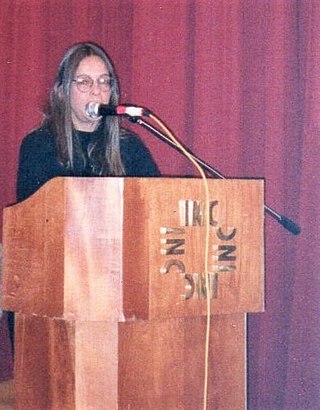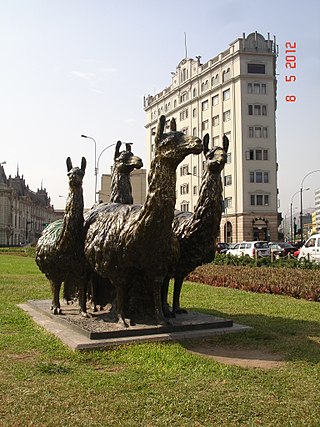Related Research Articles

Gladys Rosa Zender de Meier is a Peruvian model and beauty queen who became the first Latin American to win the Miss Universe title. She was crowned Miss Peru Universe 1957 by Miss Peru Universe 1956, Lola Sabogal Morzán.

José Sabogal was a Peruvian painter and muralist who was "the most renowned early supporter" and thus a leader in the artistic indigenist movement of his country. As Daniel Balderston, Mike Gonzalez, and Ana M. López assert, Sabogal "became Peru's militant indigenist and aesthetic nationalist, and led this movement for the next thirty years.
Peruvian art has its origin in the Andean civilizations. These civilizations rose in the territory of modern Peru before the arrival of the Spanish.

The Cusco School or Cuzco School, was a Roman Catholic artistic tradition based in Cusco, Peru during the Colonial period, in the 16th, 17th and 18th centuries. It was not limited to Cusco only, but spread to other cities in the Andes, as well as to present day Ecuador and Bolivia.
Marcos Zapata was a Native master painter from Peru known for combining Christian stories with indigenous culture. The most famous example being The Last Supper (c.1753), which represents the famous New Testament story, but with the incorporation of Andean foods such as Cuy. He studied and later taught with the Cuzco School where he had a workshop with multiple apprentices working to produce vast amount of paintings. The themes are primarily Christian subjects meant for churches in Peru and Chile.
Adrián de Alesio was a Peruvian painter and poet.
Tilsa Tsuchiya Castillo was a Peruvian printmaker and painter known for her paintings of Peruvian myths and legends. She is considered one of the greatest exemplars of Peruvian painting, having won the prestigious Bienal of Teknoquimica Prize for painting. Her teacher, Ricardo Grau, had also been presented the Bienal award in a previous year. Tsuchiya graduated from the Escuela Nacional Superior Autónoma de Bellas Artes of Peru in 1959. Tsuchiya’s work addressed the contemporary issues of gender and identity and has been linked to earlier Surrealists.
Pedro Azabache Bustamante was a Peruvian painter, pupil of Julia Codesido and Jose Sabogal and was one of the few direct followers of indigenismo. He studied at the National School of Fine Arts in Lima where he joined in 1937. In June 1944 he presented his first solo show in the exclusive exposition rooms of the cultural institution "Insula" at the invitation of the poet José Gálvez Barrenechea. In 1962, he founded the School of Fine Arts Macedonio de la Torre in Trujillo city, and was its first director.
Venancio Shinki was considered one of the most outstanding Peruvian painters. He was born in Supe, Lima, Peru. His father was Japanese and had arrived to Peru in 1915. His mother was Peruvian. He was born and raised on the Hacienda San Nicolás in Supe, north of Lima. At that time, Supe attracted a large concentration of Japanese immigrants. He has 3 children from his first marriage to Keiko Higa.

José Juan de Dios Mateo Osbaldo Botaro Lepiani Toledo was a Peruvian painter. He is primarily known for historical and patriotic scenes; notably those related to the War of the Pacific.

Isabel María Sabogal Dunin-Borkowski is a Polish-Peruvian bilingual novelist, poet, translator of Polish literature into Spanish and astrologer.
Regina Aprijaskis was a French artist established in Peru. She was known primarily for her pictorial production centered in geometrical abstraction.

Julia Wernicke was an Argentine painter and engraver. She is known as the first animalist painter from Argentina and incorporated exotic animals into her paintings. She paved the way for female artists in Argentina through many firsts, especially within the discipline of engraving. Wernicke was one of the first women to have an individual exhibition of works in Buenos Aires, in 1897; and the first person to have an individual exhibition of engraved etchings in Argentina, in 1909.
Víctor Manuel Martínez Málaga (1890–1976) was a Peruvian figurative painter, most well-known for his portraits and Andean landscapes of Southern Peru. He was the director of the Escuela Regional de Bellas Artes "Carlos Bacaflor" in Arequipa, Peru.
Julia Manuela Codesido Estenós was a Peruvian painter, one of the most significant representatives of the Peruvian plastic movement, popularly known as “indigenismo”.

Las llamas is a sculpture by Agustín Rivera Eyzaguirre located on the Paseo de los Héroes Navales in Lima, Peru. It was a gift from the Chinese colony in Peru for the fourth centenary of the Spanish foundation of Lima.

La yunta, also known as El trabajo or Los bueyes, is a bronze sculpture in the Paseo de los Héroes Navales, Lima, Peru.

Óscar Guillermo Allain Cottera is a Peruvian painter of French descent.

The National Museum of Peruvian Culture, formerly the National Archaeology Museum, is a museum dedicated to Peruvian culture in Lima, Peru.

The Ignacio Merino Municipal Pinacotheca, also known as the Pinacotheca of Lima, is a pinacotheca located at the Plaza Francia, part of the historic centre of Lima, Peru.
References
- ↑ "Great Masters of the Peruvian Painted Art". derecho.usmp.edu.pe. Law and Political Science Faculty of the San Martin University. Archived from the original on 2019-04-26. Retrieved 2024-06-06.
- ↑ Elena Izcue-Fundadora de la imagineria precolombina http://sunlight4.blogspot.com/2008/10/elena-izcue-fundadora-de-la-imagineria.html
- ↑ ISSUU Lundero 416 August 2013 http://issuu.com/alobso/docs/lundero_416/8
- ↑ Art Experts http://www.artexpertswebsite.com/pages/artists/rivero.php
- ↑ Alfonso Castrillon Vizcarra: "LOS INDEPENDIENTES: instancias y antagonismos en la plástica peruana de los años 37 al 47" "Archived copy" (PDF). Archived from the original (PDF) on 2014-03-01. Retrieved 2014-02-24.
{{cite web}}: CS1 maint: archived copy as title (link) - ↑ Mirko Lauer - Bodegón de bodegones, comida y artes visuales en el Perú http://www.blogdelfondo.com/2010/10/memorias-de-un-comensal-bodegon-de.html
- ↑ Leonardini, Nanda (2003). El grabado en el Perú republicano: diccionario histórico (in Spanish). UNMSM. ISBN 978-9972-46-225-2.
- ↑ Chronology of the Peruvian Painter Mario Urteaga - Buntinx - Wuffarden
- ↑ ArsLatino Magazine http://www.arslatino.com/es/magazine/reportajes/10-los-independientes-del-peru
- ↑ Turismo, Lima, N 128 [s.p.] Raygada https://mnba.gob.ar/coleccion/obra/2138 Archived April 1, 2016, at the Wayback Machine
- ↑ Caretas 1995 http://www.caretas.com.pe/1346/cultural/cultural1346.html
- ↑ Caretas 1999 http://www.caretas.com.pe/1999/1556/culturales/culturales.htm
- ↑ ICPNA "ICPNA - Instituto Cultural Peruano Norteamericano". Archived from the original on 2014-03-01. Retrieved 2014-02-25.
- ↑ Municipalidad de Lima, January 21, 2012
- ↑ Gabriela Lavarello de Velaochaga - 7 Pintores Peruanos http://www.authorstream.com/Presentation/linonil-135169-7-PINTORES-PERUANOS-sXIX-2-Gabriela-Lavarello-de-Velaochaga-2007-Enrique-Domingo-Barreda-LaosLima-peru-Celebrities-ppt-powerpoint
- ↑ Mercado Libre http://articulo.mercadolibre.com.pe/MPE-408447641-oleo-bernardo-rivero-procesion-en-el-cusco-1921-54-cms-x-64-_JM?redirectedFromSearch=true
- ↑ askART http://www.askart.com/artist/Bernardo_Rivero/11256362/Bernardo_Rivero.aspx
- ↑ Fotolog http://us.fotolog.com/peru_art/20246997/ Archived 2016-03-04 at the Wayback Machine
- ↑ Anthropology of Food
- ↑ Antiguedades en Vitrina "Cuadro de Bernardo Rivero". Archived from the original on 2014-03-02. Retrieved 2014-02-25.
- ↑ Municipalidad de Lima, January 21, 2012